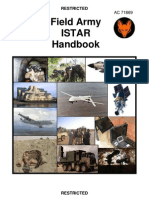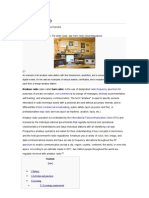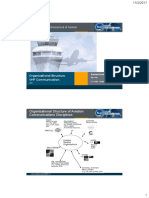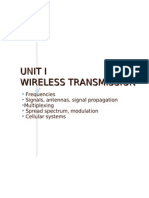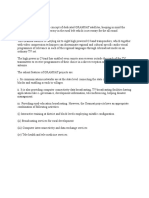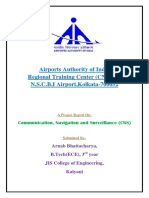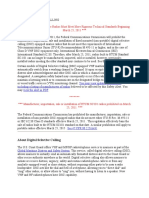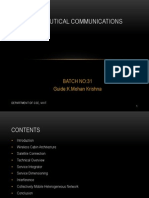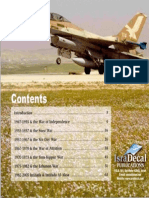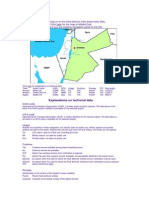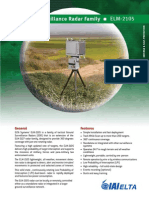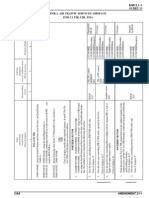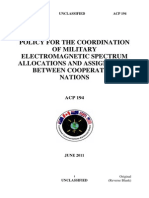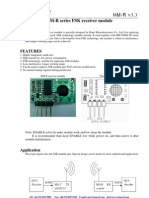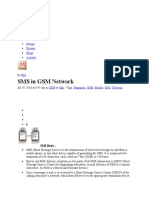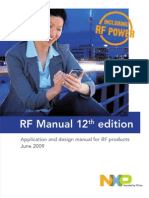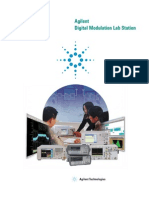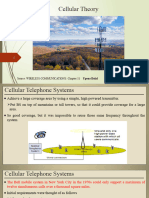Collection
Collection
Uploaded by
Samar SamerCopyright:
Available Formats
Collection
Collection
Uploaded by
Samar SamerOriginal Description:
Copyright
Available Formats
Share this document
Did you find this document useful?
Is this content inappropriate?
Copyright:
Available Formats
Collection
Collection
Uploaded by
Samar SamerCopyright:
Available Formats
Airband
Airband
Airband or Aircraft band is the name for a group of frequencies in the VHF radio spectrum allocated to radio communication in civil aviation, sometimes also referred to as VHF, or phonetically as "Victor". Different sections of the band are used for radionavigational aids and air traffic control.[1][2][3][4] In most countries a license to operate airband equipment is required and the operator is tested on competency in procedures, language and the use of the phonetic alphabet.[2][5]
A Bendix/King KY197 Airband VHF communication radio mounted above a Cessna ARC RT-359A Transponder (the beige box) in a light aircraft instrument panel. The VHF radio displays the active frequency of 122.8 MHz and a standby frequency of 121.5 MHz, UNICOM and guard frequencies, respectively.
Spectrum usage
The VHF airband uses the frequencies between 108 and 137MHz. The lowest 10MHz of the band, from 108117.95MHz, is split into 200 narrow-band channels of 50 kHz. These are reserved for navigational aids such as VOR beacons, fan marker beacons, Automatic Terminal Information Service (ATIS) and Automated Surface Observing System (ASOS) messages, and precision approach systems such as ILS localizers or LAAS.[2][3][4] As of 2012, most countries divide the upper 19MHz into 760 channels for amplitude modulation voice transmissions, on frequencies from 118136.975MHz, in steps of 25 kHz. In Europe, it is becoming common to further divide those channels into three (8.33kHz channel spacing), potentially permitting 2,280 channels. Some channels between 123.100 and 135.950 are available in the US to other users such as government agencies, commercial company advisory, search and rescue, military aircraft, glider and ballooning air-to-ground, flight test and national aviation authority use. A typical transmission range of an aircraft flying at cruise altitude (35,000 ft), is about 200 miles in good weather conditions.[2][4][6][7]
Antenna array at Amsterdam Airport Schiphol
Airband
Other bands
Aeronautical voice communication is also conducted in other frequency bands, including satellite voice on Inmarsat and high frequency voice in the North Atlantic and remote areas. Military aircraft also use a dedicated UHF-AM band from 220.0399.95MHz for air-to-air and air-to-ground, including air traffic control communication. This band has a designated emergency and guard channel of 243.0MHz.[2][8] Some types of navaids, such as Non-directional beacons and Distance Measuring Equipment, do not operate on these frequencies; in the case of NDBs the Low frequency and Medium frequency bands are used between 190415kHz and 510535kHz. The ILS glide path operates in the UHF frequency range of 329.3335.0MHz, and DME also uses UHF from 9621150MHz.[3]
Channel spacing
Channel spacing for voice communication on the airband was originally 200kHz[9] until 1947, providing 70 channels from 118 to 132MHz. Some radios of that time provided receive-only coverage below 118MHz for a total of 90 channels. From 19471958 the spacing became 100kHz; from 1954 split once again to 50kHz and the upper limit extended to 135.95MHz (360 channels), and then to 25kHz in 1972 to provide 720 usable channels. On 1 January 1990 the frequencies between 136.000 and 136.975MHz were added, resulting in 760 channels.[6] Increasing air traffic congestion has led to further subdivision into narrow-band 8.33kHz channels in the ICAO European region; all aircraft flying above 19,500 feet are required to have communication equipment for this channel spacing.[2][10][11] Outside of Europe, 8.33kHz channels are permitted in many countries but not widely used as of 2012. The emergency communication channel 121.5MHz is the only channel that retains 100 kHz bandwidth.
Modulation
Aircraft communications radio operations worldwide use amplitude modulation, predominantly A3E double sideband with full carrier on VHF and UHF, and J3E single sideband with suppressed carrier on HF. Besides being simple, power-efficient and compatible with legacy equipment, AM and SSB permit stronger stations to override weaker or interfering stations, and don't suffer from the capture effect found in FM. Even if a pilot is transmitting, a control tower can "talk over" that transmission and other aircraft will hear a somewhat garbled mixture of both transmissions, rather than just one or the other. Even if both transmissions are received with identical signal strength, a heterodyne will be heard where no such indication of blockage would be evident in an FM system. Alternative analog modulation schemes are under discussion, such as the "CLIMAX"[12] multi-carrier system and offset carrier techniques to permit more efficient utilization of spectrum.
Digital radio
A switch to digital radios has been contemplated, as this would greatly increase capacity by reducing the bandwidth required to transmit speech. Other benefits from digital coding of voice transmissions include decreased susceptibility to electrical interference and jamming. The change-over to digital radio has yet to happen, partly because the mobility of aircraft necessitates complete international cooperation to move to a new system and also the time implementation for subsequent changeover.[13][14] Another factor delaying the move to any digital mode is the need to retain the ability for one station to override another in an emergency.
Airband
Unauthorised use
It is illegal to broadcast on the Airband frequencies without a suitable license. Many countries' regulations also restrict communications in the airband. For instance in Canada airband communications are limited to those required for "the safety and navigation of an aircraft; the general operation of the aircraft; and the exchange of messages on behalf of the public. In addition, a person may operate radio apparatus only to transmit a non-superfluous signal or a signal containing non-profane or non-obscene radiocommunications."[2] While it is not an offence to listen to voice transmissions in the airband frequencies, it may be an offence to possess such equipment in certain countries. Instances of such illegal activity has been the subject of international situations between governments when tourists bring airband equipment into countries which ban the possession and use of such equipment.[15][16]
References
[1] H. P. Westman (ed), Reference Data for Radio Engineers Fifth Edition, Howard W. Sams and Co, 1968, page 1-6 [2] Transport Canada (September 2010). "Com - 5.0 radio communications" (http:/ / www. tc. gc. ca/ eng/ civilaviation/ publications/ tp14371-com-5-0-466. htm). . Retrieved 14 February 2011. [3] Transport Canada (September 2010). "Com - 3.0 radio navigation aids" (http:/ / www. tc. gc. ca/ eng/ civilaviation/ publications/ tp14371-com-3-0-2546. htm). . Retrieved 14 February 2011.
[4] "Aviation Radio Bands and Frequencies" (http:/ / www. smeter. net/ spectrum/ aviation. php). Smeter network 2011. . Retrieved 16 February 2011. [5] "Radio Telephony Training Syllabus" (http:/ / www. cotswoldgliding. co. uk/ members/ sites/ default/ files/ radio_training. pdf). Cotswold Gliding Club - date undisclosed. . Retrieved 16 February 2011. [6] "Requirements for 760 channel VHF radio for Aeronautical operations" (http:/ / www. ramairskyways. com/ html/ Documents/ AC90-50D_VHF. pdf). Federal aviation agency 1992. . Retrieved 2011-02-14. [7] "VII. ELECTRONIC AIDS TO INSTRUMENT FLYING" (http:/ / www. faatest. com/ books/ ifrh/ 7-1. htm). FAA test company - date undisclosed. . Retrieved 2011-02-17. [8] DAOT 5: C-12-118-000/MB-000 Operating Instructions CH118 Helicopter (unclassified), Change 2, 23 April 1987, Page 1-51. Department of National Defence [9] "8.33 kHz Channel spacing what is this?" (http:/ / www. roger-wilco. net/ 8-33-khz-channel-spacing--what-is-this/ ). Roger-Wilco. 2010-04-03. . Retrieved 2012-05-10. [10] "Aircraft frequencies for UK and Europe" (http:/ / www. garfnet. org. uk/ joomla/ index. php?option=com_content& view=article& id=112:aircraft-frequencies-uk-a-europe& catid=3:radio-frequencies& Itemid=59). Garfnet organisation 2009. . Retrieved 14 February 2011. [11] "8.33kHz Programme" (http:/ / www. eurocontrol. int/ vhf833/ public/ subsite_homepage/ homepage. html). Eurocontrol. . Retrieved 2007-12-24. [12] EuroControl, CLIMAX/8.33: To extend 8.33 kHz benefits (http:/ / legacy. icao. int/ anb/ panels/ acp/ wg/ t/ wgt1/ acp-wgt-1-wp19-climax leaflet v1r0_4. pdf), ICAO, October 2007 [13] "Affordable real-time digital voice transmission using Voip technology" (http:/ / docs. google. com/ viewer?a=v& q=cache:OviVUcKRA_IJ:www. virtualacquisitionshowcase. com/ document/ 1191/ briefing+ digital+ voice+ transmission+ over+ radio& hl=en& gl=uk& pid=bl& srcid=ADGEESgbs97f0gJ8VAdVkcYnvxcr_AVm72VxDIbdslnMaAIKlfcOrtLKQrHPBZlkx3qtyrR4rNsKxt5Os1afDJoXaACZvkogEVgc4C-Uqf2cJg_IzSxI5hPg sig=AHIEtbQ18RbvNhWCI8QuiaeMiHW-iH0ZAA). Command NAVAIR 2 January 2010. . Retrieved 16 February 2011. [14] "Aircraft centric digital CNS" (http:/ / docs. google. com/ viewer?a=v& q=cache:03RdjJriOk8J:www. sita. aero/ file/ 530/ Aircraft_centric_digital_cns_position_paper. pdf+ "proposed+ digital+ channels+ for+ aircraft+ communications"& hl=en& gl=uk& pid=bl& srcid=ADGEESiFqWV6y--edA7Zfwwtbh5vEiiy4_yoNsEVqmSEHgSIbzIyOwWz2HakvklROWBOvJW0S76oxyTg76UqLokZwUUaS6jGE4eWLedUYvjF_ol7rH sig=AHIEtbSLp5k4urC-TLVC7K5IM4UdpoAauA). CITA 2010. . Retrieved 14 February 2011. [15] "Greek drama in capital" (http:/ / www. algarveresident. com/ story. asp?ID=5776). Algarve resident 2011. . Retrieved 16 February 2011. [16] "Plane-spotters 'ignored warnings'." (http:/ / news. bbc. co. uk/ 1/ hi/ uk/ 1950198. stm) BBC News, 25 April 2002. Retrieved: 14 March 2007. Quote: "Note-taking in conjunction with other activities may be detrimental (to Greek security)."
Article Sources and Contributors
Article Sources and Contributors
Airband Source: http://en.wikipedia.org/w/index.php?oldid=492417428 Contributors: Ahunt, Altaphon, Armando, ArnoldReinhold, Arpingstone, Blair Bonnett, Cacycle, Change1211, Charlene.fic, Chris the speller, CosineKitty, Cottingham, Davgrps, David Jordan, Elonka, Epbr123, Ericg, Erzahler, Explicit, Flauto Dolce, Fnlayson, Francis E Williams, GRAHAMUK, Harryzilber, Ices2Csharp, KevM, Krellis, Mr.hogi, Radiojon, Schoen, SchreiberBike, Sgeureka, Smsmonster, Tabletop, Wtshymanski, 20 anonymous edits
Image Sources, Licenses and Contributors
File:CessnaARC-RT-359ATransponder04.jpg Source: http://en.wikipedia.org/w/index.php?title=File:CessnaARC-RT-359ATransponder04.jpg License: Public Domain Contributors: Original uploader was Ahunt at en.wikipedia Image:COMstationEHAM.jpg Source: http://en.wikipedia.org/w/index.php?title=File:COMstationEHAM.jpg License: Creative Commons Attribution-Sharealike 3.0 Contributors: Smsmonster
License
Creative Commons Attribution-Share Alike 3.0 Unported //creativecommons.org/licenses/by-sa/3.0/
You might also like
- Uk Istar Handbook 2007Document87 pagesUk Istar Handbook 2007Alexjohn2009100% (4)
- TNT ApnDocument3 pagesTNT Apnnoumaniub1No ratings yet
- Radio Telephony PDFDocument199 pagesRadio Telephony PDFSuraj Singh100% (5)
- Essential 4G Guide: Learn 4G Wireless In One DayFrom EverandEssential 4G Guide: Learn 4G Wireless In One DayRating: 4.5 out of 5 stars4.5/5 (12)
- GMDSS Lection Week 3Document17 pagesGMDSS Lection Week 3George KandelakiNo ratings yet
- Amateur Radio: "Ham Radio" Redirects Here. For Other Uses, SeeDocument14 pagesAmateur Radio: "Ham Radio" Redirects Here. For Other Uses, SeeGoutham KomarNo ratings yet
- GMDS - Course - FinalDocument282 pagesGMDS - Course - FinalLuisPazPerdomo100% (1)
- Search and Rescue Maritime Safety Information TonnageDocument4 pagesSearch and Rescue Maritime Safety Information Tonnagemark sevaNo ratings yet
- RN Stoenciu Cosmin SilviuDocument37 pagesRN Stoenciu Cosmin SilviuSilviu CosminNo ratings yet
- Referat GMDSSDocument8 pagesReferat GMDSSNichifor Andrei StefanNo ratings yet
- On Aircraft ComDocument24 pagesOn Aircraft ComAakriti GuptaNo ratings yet
- Marcom: Performed by Rafael Espinoza - Emmanuel Quintero Jean Carlos Cervantes - Armando QuirogaDocument10 pagesMarcom: Performed by Rafael Espinoza - Emmanuel Quintero Jean Carlos Cervantes - Armando Quirogaemmanuel paezNo ratings yet
- COMMUNICATION AND NAVIGATION SYSTEMS ReportDocument7 pagesCOMMUNICATION AND NAVIGATION SYSTEMS ReportnathanNo ratings yet
- GMDSSDocument31 pagesGMDSSJohn Gerald Lipata Reyno100% (3)
- I. VHF CommunicationsDocument12 pagesI. VHF CommunicationsSamuel OyelowoNo ratings yet
- Amateur RadioDocument14 pagesAmateur RadioUtkarsh GuptaNo ratings yet
- 1 - Organizational Structure. VHF ComsDocument16 pages1 - Organizational Structure. VHF ComsTejas RathodNo ratings yet
- Marine CommunicationsDocument32 pagesMarine CommunicationsMahami M Prosper100% (1)
- Safety Sense Leaflet 22 Radiotelephony 20130121SSL22Document20 pagesSafety Sense Leaflet 22 Radiotelephony 20130121SSL22Konrad PalczynskiNo ratings yet
- Stay Tuned: 8.33 KHZ Channel Spacing Below Flight Level 195Document12 pagesStay Tuned: 8.33 KHZ Channel Spacing Below Flight Level 195Marco AlfieriNo ratings yet
- R Rec M.2059 0 201312 P!!MSW eDocument21 pagesR Rec M.2059 0 201312 P!!MSW esanthoshinigoNo ratings yet
- Chapter 1 TERRESTRIAL (Unlocked by WWW - Freemypdf.com)Document20 pagesChapter 1 TERRESTRIAL (Unlocked by WWW - Freemypdf.com)sapry eldeepNo ratings yet
- EGY NTRA June21 MaritimeDocument10 pagesEGY NTRA June21 MaritimeSella BanyenzaNo ratings yet
- Unit I Wireless TransmissionDocument22 pagesUnit I Wireless TransmissionNandu Rajendran100% (1)
- Intro To GMDSSDocument25 pagesIntro To GMDSSBilinschi Luca Ionel100% (1)
- Marcom Report UpdatedDocument42 pagesMarcom Report UpdatedDenmark SinayNo ratings yet
- Proiect Ciuclea Alin Petrica GMDSS IFR FE41Document30 pagesProiect Ciuclea Alin Petrica GMDSS IFR FE41Alin PetricaNo ratings yet
- Unit 3 (2)Document21 pagesUnit 3 (2)diserplayzNo ratings yet
- GramsatDocument17 pagesGramsatAdam WellsNo ratings yet
- Introduction To Global Maritime Distress Safety SystemDocument6 pagesIntroduction To Global Maritime Distress Safety Systemmark john batingalNo ratings yet
- A Study of AircraftDocument2 pagesA Study of AircraftAmir AsadyNo ratings yet
- Introduction To Global Maritime Distress Safety System (GMDSS) - What You Must KnowDocument6 pagesIntroduction To Global Maritime Distress Safety System (GMDSS) - What You Must KnowGiorgi Kandelaki100% (1)
- PRW-18 Maritime Wireless Communications - Ver0Document35 pagesPRW-18 Maritime Wireless Communications - Ver0saatchi.negarNo ratings yet
- Marine Electronic DevicesDocument6 pagesMarine Electronic Devices6qf7yt2sxcNo ratings yet
- GMDSS: Global Maritime Distress and Safety SystemDocument110 pagesGMDSS: Global Maritime Distress and Safety SystemAmin Al Qawasmeh100% (3)
- Airports Authority of India Regional Training Center (CNS), ER N.S.C.B.I Airport, Kolkata-700052Document33 pagesAirports Authority of India Regional Training Center (CNS), ER N.S.C.B.I Airport, Kolkata-700052rose whiteNo ratings yet
- MIdway Report On Working of ATCDocument21 pagesMIdway Report On Working of ATCSwati DhuliNo ratings yet
- SRC VHF HandoutDocument28 pagesSRC VHF HandoutWing Wing100% (1)
- Radiotelephony Communications and ProceduresDocument24 pagesRadiotelephony Communications and ProceduresDirk DigglerNo ratings yet
- Digital Selective CallingDocument7 pagesDigital Selective CallingDicky KusdyNo ratings yet
- Terrestrial CommunicationsDocument21 pagesTerrestrial CommunicationsalexNo ratings yet
- IALA Maritime Radio Communications PlanDocument57 pagesIALA Maritime Radio Communications Plansanjin_valcicNo ratings yet
- Introduction To GMDSS: Safety-SystemDocument7 pagesIntroduction To GMDSS: Safety-Systemferkm100% (1)
- Aircraft Communication SystemsDocument20 pagesAircraft Communication Systemsfaladeemmanuel55No ratings yet
- MsDocument70 pagesMsswiet631No ratings yet
- AvionicsDocument108 pagesAvionicsChiranjivi KuthumiNo ratings yet
- Airport Authority of IndiaDocument51 pagesAirport Authority of IndiaNeha Bhatia100% (1)
- RFSG - wp03 Annex 10 Vol V Chapter 4 VHF ComDocument20 pagesRFSG - wp03 Annex 10 Vol V Chapter 4 VHF ComMarcus DragoNo ratings yet
- Review Questions For Graded Recitation 2Document4 pagesReview Questions For Graded Recitation 2Andre NapalaNo ratings yet
- Very-Small-Aperture Terminal: From Wikipedia, The Free EncyclopediaDocument5 pagesVery-Small-Aperture Terminal: From Wikipedia, The Free EncyclopediaAdi MijieNo ratings yet
- Discussed Material September 12 2023 2Document16 pagesDiscussed Material September 12 2023 2kaning lamigNo ratings yet
- Gmdss Basic ConceptDocument6 pagesGmdss Basic ConceptDoug8183100% (3)
- Global Maritime Distress and Safety System - Wikipedia, The Free EncyclopediaDocument8 pagesGlobal Maritime Distress and Safety System - Wikipedia, The Free Encyclopediasmfa1453No ratings yet
- Radio Altimeter FinalDocument7 pagesRadio Altimeter FinalThomas AbrahamNo ratings yet
- Echo 1-17Document258 pagesEcho 1-17lone survivorNo ratings yet
- R Rec M.1371 5 201402 I!!pdf eDocument150 pagesR Rec M.1371 5 201402 I!!pdf eAntonKrainovNo ratings yet
- Aeronautical Communications: V.Krishna Prasad (08BQ1A0588) Batch No:31 Guide:K.Mohan KrishnaDocument22 pagesAeronautical Communications: V.Krishna Prasad (08BQ1A0588) Batch No:31 Guide:K.Mohan KrishnaKrishna PrasadNo ratings yet
- Avionics Question Bank and NotesDocument29 pagesAvionics Question Bank and NotesFaisal Muhammed Mavathu100% (2)
- EYESEATEADocument39 pagesEYESEATEAJohn Joseph Totanes ZantuaNo ratings yet
- Radio Control for Model Ships, Boats and AircraftFrom EverandRadio Control for Model Ships, Boats and AircraftRating: 5 out of 5 stars5/5 (1)
- JTTP For Laser Designation OpsDocument149 pagesJTTP For Laser Designation Ops...tho the name has changed..the pix remains the same.....No ratings yet
- N0016411RJQ94 11RJQ94 PerfSpecDocument26 pagesN0016411RJQ94 11RJQ94 PerfSpecSamar SamerNo ratings yet
- To C Colors MarkingsDocument1 pageTo C Colors MarkingsSamar SamerNo ratings yet
- Rising Terrain Up To 3 133, About 5 KM West of ADDocument1 pageRising Terrain Up To 3 133, About 5 KM West of ADSamar SamerNo ratings yet
- Data Link Elk1850Document2 pagesData Link Elk1850Samar SamerNo ratings yet
- Israel MissileDocument39 pagesIsrael MissileSamar SamerNo ratings yet
- Israel MissileDocument39 pagesIsrael MissileSamar SamerNo ratings yet
- Airprt CodingDocument2 pagesAirprt CodingSamar SamerNo ratings yet
- 37111Document12 pages37111Samar SamerNo ratings yet
- Airprt CodingDocument2 pagesAirprt CodingSamar SamerNo ratings yet
- 37117Document12 pages37117Samar SamerNo ratings yet
- HPCR Manual (AirWar)Document64 pagesHPCR Manual (AirWar)tex0001No ratings yet
- 36883Document7 pages36883Samar SamerNo ratings yet
- AIP Israel ENR 2.2 1 01 DEC 96: Enr 2.2 Other Regulated AirspaceDocument0 pagesAIP Israel ENR 2.2 1 01 DEC 96: Enr 2.2 Other Regulated AirspaceSamar SamerNo ratings yet
- 39832Document0 pages39832Samar SamerNo ratings yet
- Esdp/Pesd: Council of The European Union Brussels, 5 July 2005Document18 pagesEsdp/Pesd: Council of The European Union Brussels, 5 July 2005Samar SamerNo ratings yet
- Enr 2-1Document2 pagesEnr 2-1Samar SamerNo ratings yet
- AIP Israel ENR 6.7 01 DEC 96: Military Training Areas - Index ChartDocument0 pagesAIP Israel ENR 6.7 01 DEC 96: Military Training Areas - Index ChartSamar SamerNo ratings yet
- ACP194Document32 pagesACP194Samar SamerNo ratings yet
- Audit of Major Bands: Annex BDocument27 pagesAudit of Major Bands: Annex BSamar SamerNo ratings yet
- INNCOM Integrated Room Automated System Specifications 25510Document17 pagesINNCOM Integrated Room Automated System Specifications 25510er.bhagwanNo ratings yet
- 4ET504 Antenna Wave PropagationDocument1 page4ET504 Antenna Wave PropagationBabu kNo ratings yet
- Rr420402 Radar EngineeringDocument4 pagesRr420402 Radar EngineeringandhracollegesNo ratings yet
- DBXLH 6565C VTMDocument4 pagesDBXLH 6565C VTMMarianoNo ratings yet
- Damm System Brochure - Ver 32 - l01 - SpreadDocument5 pagesDamm System Brochure - Ver 32 - l01 - SpreadVíctor CasadoNo ratings yet
- HM-R Series FSK Receiver Module: GeneralDocument4 pagesHM-R Series FSK Receiver Module: GeneralmecatronicanueveNo ratings yet
- ComunicationDocument56 pagesComunicationWaqar AliNo ratings yet
- GSM Call FlowDocument19 pagesGSM Call Flowprisha4No ratings yet
- Final Activity D-WatchDocument8 pagesFinal Activity D-WatchRenefrid TejeroNo ratings yet
- HBX 6516DS VTMDocument5 pagesHBX 6516DS VTMVinayak NakhavaNo ratings yet
- Under The Provisions of The SOLAS 1974 As Amended and The Rules For Radio Installations For GMDSS ShipsDocument10 pagesUnder The Provisions of The SOLAS 1974 As Amended and The Rules For Radio Installations For GMDSS ShipsthỏaNo ratings yet
- 9 Counter-Drone Technologies To Detect and Stop Drones TodayDocument1 page9 Counter-Drone Technologies To Detect and Stop Drones TodayNikolaiTihinovNo ratings yet
- NXP RF Manual 12th EditionDocument97 pagesNXP RF Manual 12th EditionA. VillaNo ratings yet
- BSC RNC PresentationDocument20 pagesBSC RNC Presentationmartin.taruvinga8335No ratings yet
- CDMA PrincipleDocument40 pagesCDMA Principlewll scoNo ratings yet
- Bandwidth Allocation Policy Using The Game Theory Model in Heterogeneous Wireless NetworksDocument8 pagesBandwidth Allocation Policy Using The Game Theory Model in Heterogeneous Wireless NetworksInternational Journal of Application or Innovation in Engineering & ManagementNo ratings yet
- Agilent Digital Modulation LabDocument8 pagesAgilent Digital Modulation LabEndah FitrianiNo ratings yet
- Appendix 3: Calculation and Measurements For The Purposes of Controlling Mobile Broadband Data Network Signal CoverageDocument7 pagesAppendix 3: Calculation and Measurements For The Purposes of Controlling Mobile Broadband Data Network Signal CoverageRaaysha ThakurNo ratings yet
- Analysis Capture Probability Performance For: Wireless LANDocument5 pagesAnalysis Capture Probability Performance For: Wireless LANJean ReneNo ratings yet
- Unit 4Document77 pagesUnit 4baidnirvana8No ratings yet
- Aerials - Gernsback's 1938Document36 pagesAerials - Gernsback's 1938ameliagesticone100% (1)
- Mentum Planet 5 7 LTE PDFDocument168 pagesMentum Planet 5 7 LTE PDFJuan Carlos Zapata GarciaNo ratings yet
- Amateur Radio Licensing Examitation Question BankDocument183 pagesAmateur Radio Licensing Examitation Question BankSuvendu SahaNo ratings yet
- Gps in Transimission ProtectionDocument21 pagesGps in Transimission ProtectionAshutosh TrivediNo ratings yet
- Sea-Tel Onboard Personnel Training DAC-2202 Legacy Rev1.1Document50 pagesSea-Tel Onboard Personnel Training DAC-2202 Legacy Rev1.1aveselov88No ratings yet
- CWR WNTN Weekly ReportDocument2 pagesCWR WNTN Weekly Reportmoti gudisaNo ratings yet
- Frequency ModulationDocument76 pagesFrequency ModulationAllanki Sanyasi Rao86% (7)
- Octobox Mpe (Multipath Emulator) TestbedDocument17 pagesOctobox Mpe (Multipath Emulator) TestbedrfidguysNo ratings yet
- Seminar On Wireless Charging of Mobile DevicesDocument24 pagesSeminar On Wireless Charging of Mobile DevicesGourish Amonkar100% (1)
